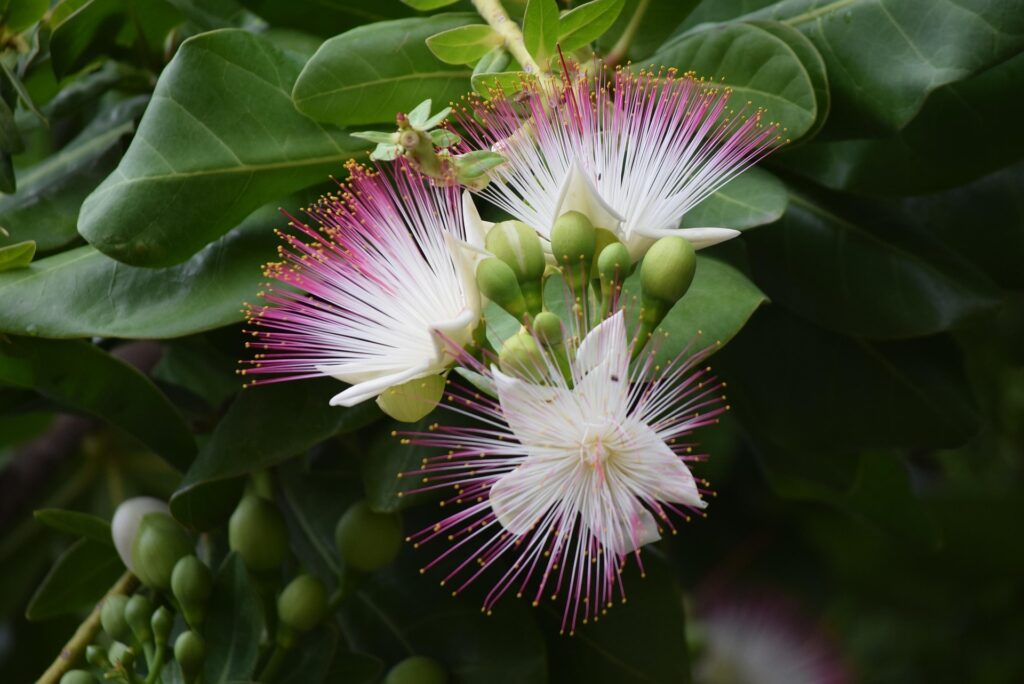
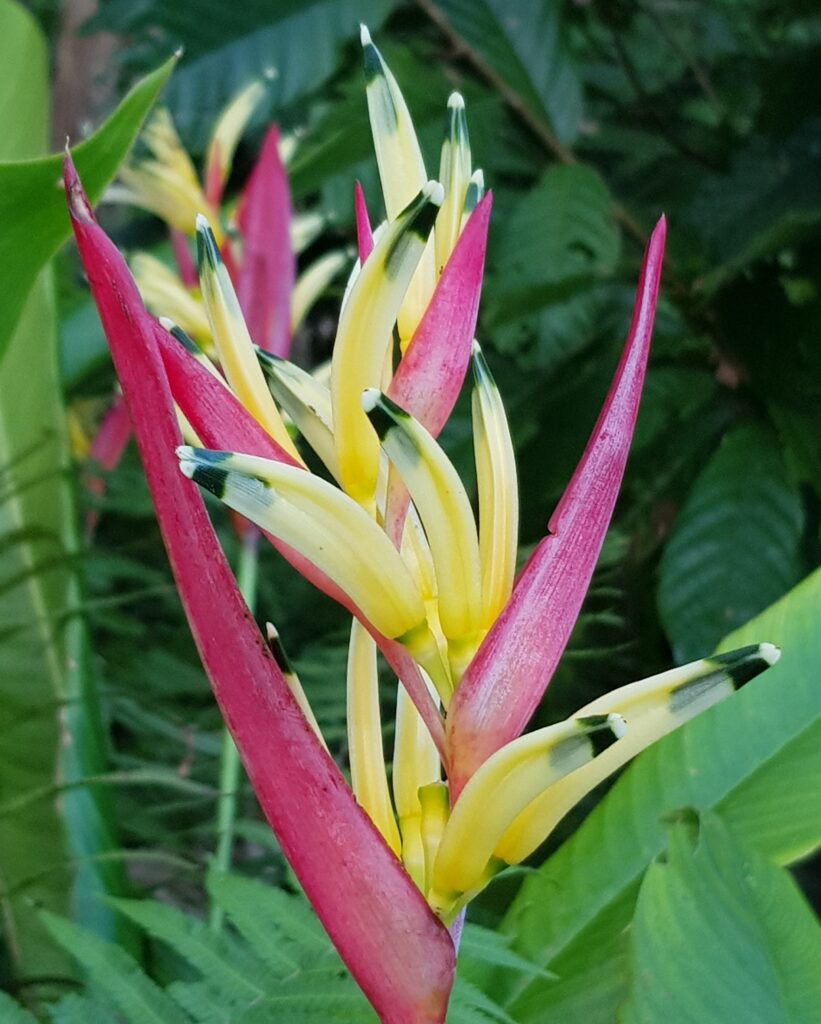
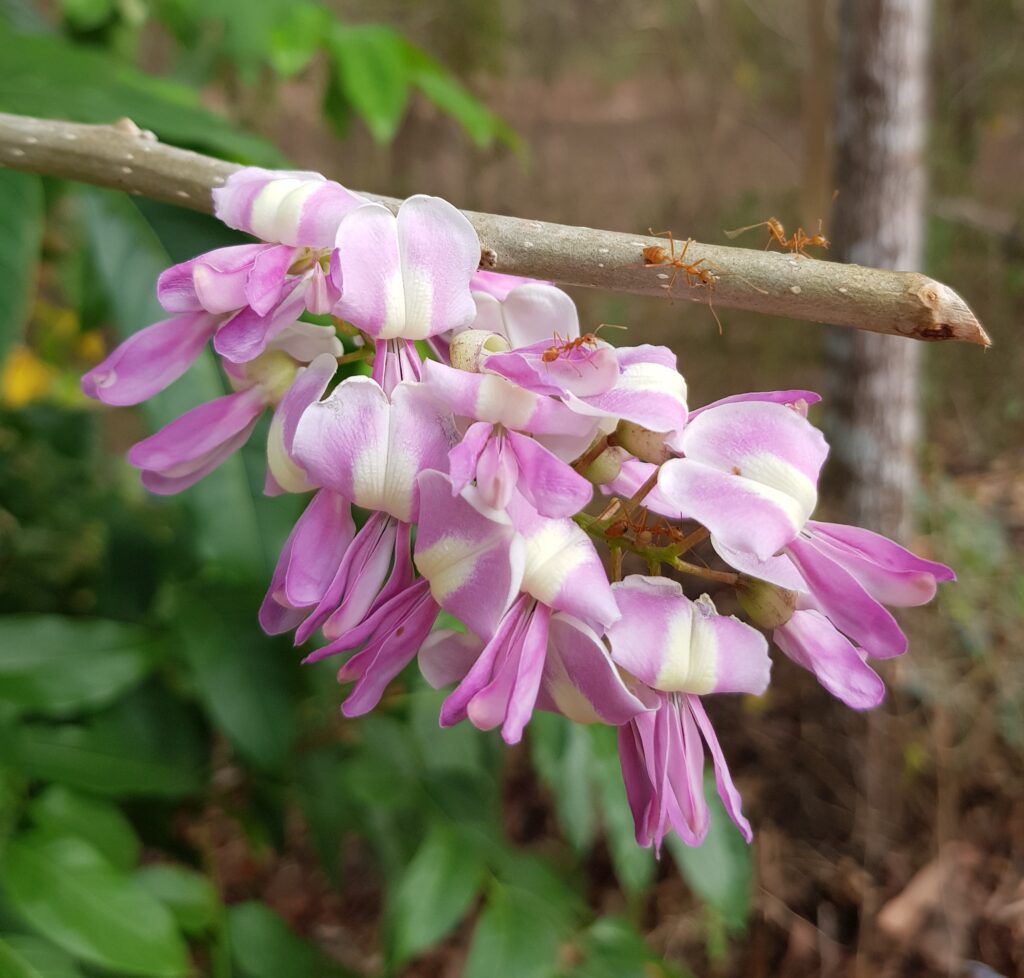
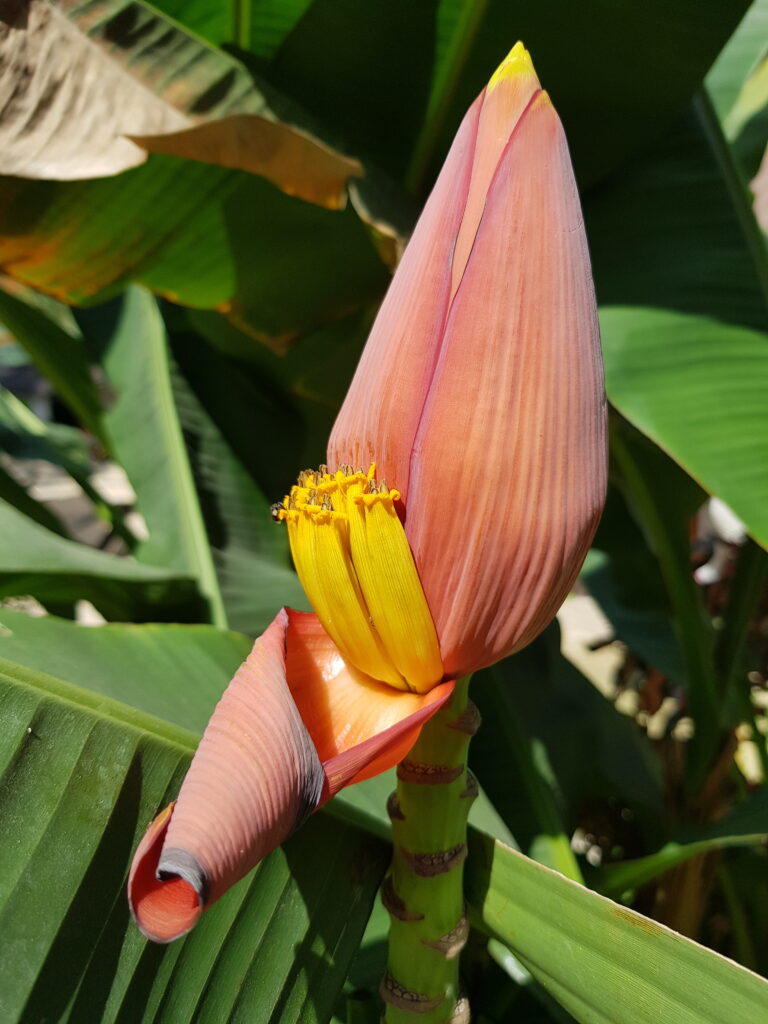
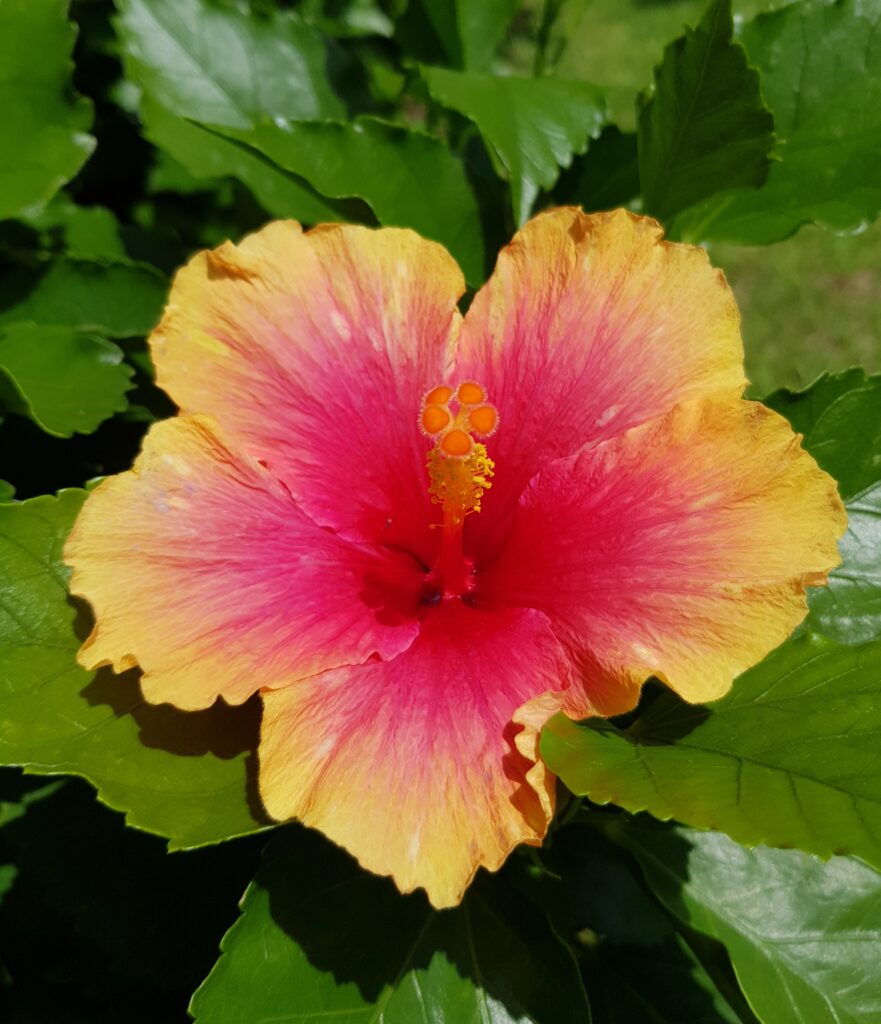
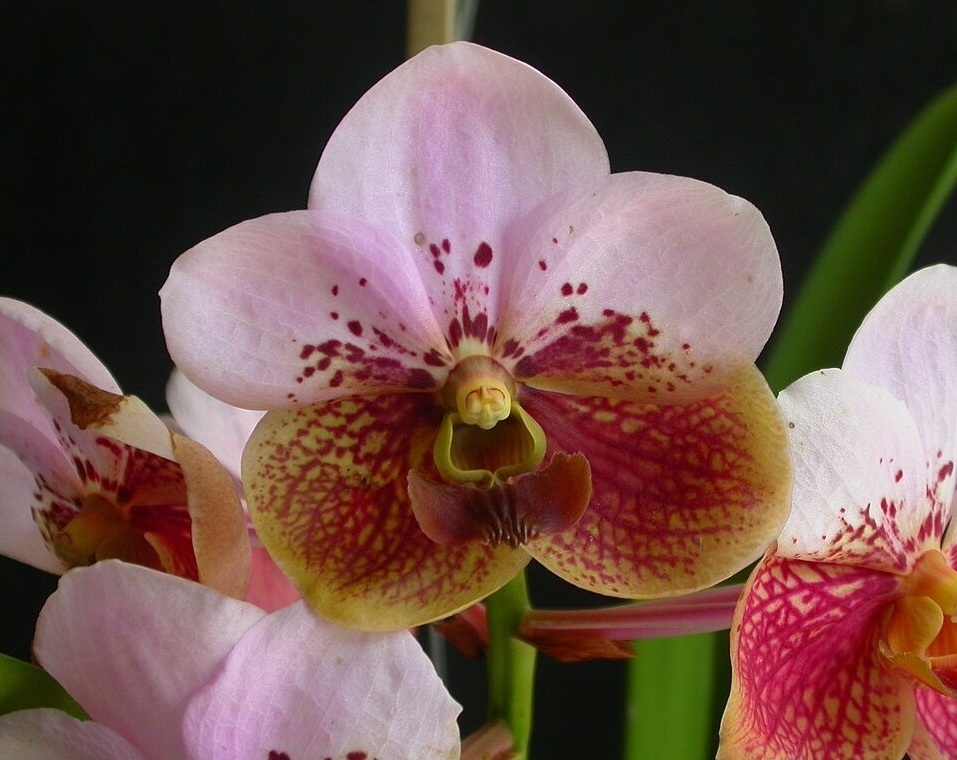
- National Tree Narra
- National Flower Sampaguita
- Bananas
- Bougainvillea
- Coconut Palm
- Fish Poison Tree
- Heliconia
- Hibiscus
- Ixora
- Mango Tree
- Orchids
- Papaya
- Taro
- Ylang-Ylang
Plant life in the Philippines
National Tree Narra
Pterocarpus indicus, known as Narra in the Philippines, is the country’s official national tree. With its broad growth and wide canopy, it not only shapes the landscape of many regions but also holds special symbolic and ecological significance.
Narra trees are hardy, adaptable and can live for a very long time. Healthy specimens typically reach ages of 100 to 200 years, and in some cases even much older – especially when growing in protected, natural habitats without commercial exploitation. They thrive in tropical climates and contribute significantly to the local microclimate with their dense foliage. Additionally, they provide habitat and food for numerous animal species and help stabilize the soil.
As a symbol, the Narra represents strength, resilience, and dignity – qualities closely linked to Filipino identity. Its valuable reddish-brown wood is traditionally used for furniture, carving art, and construction.
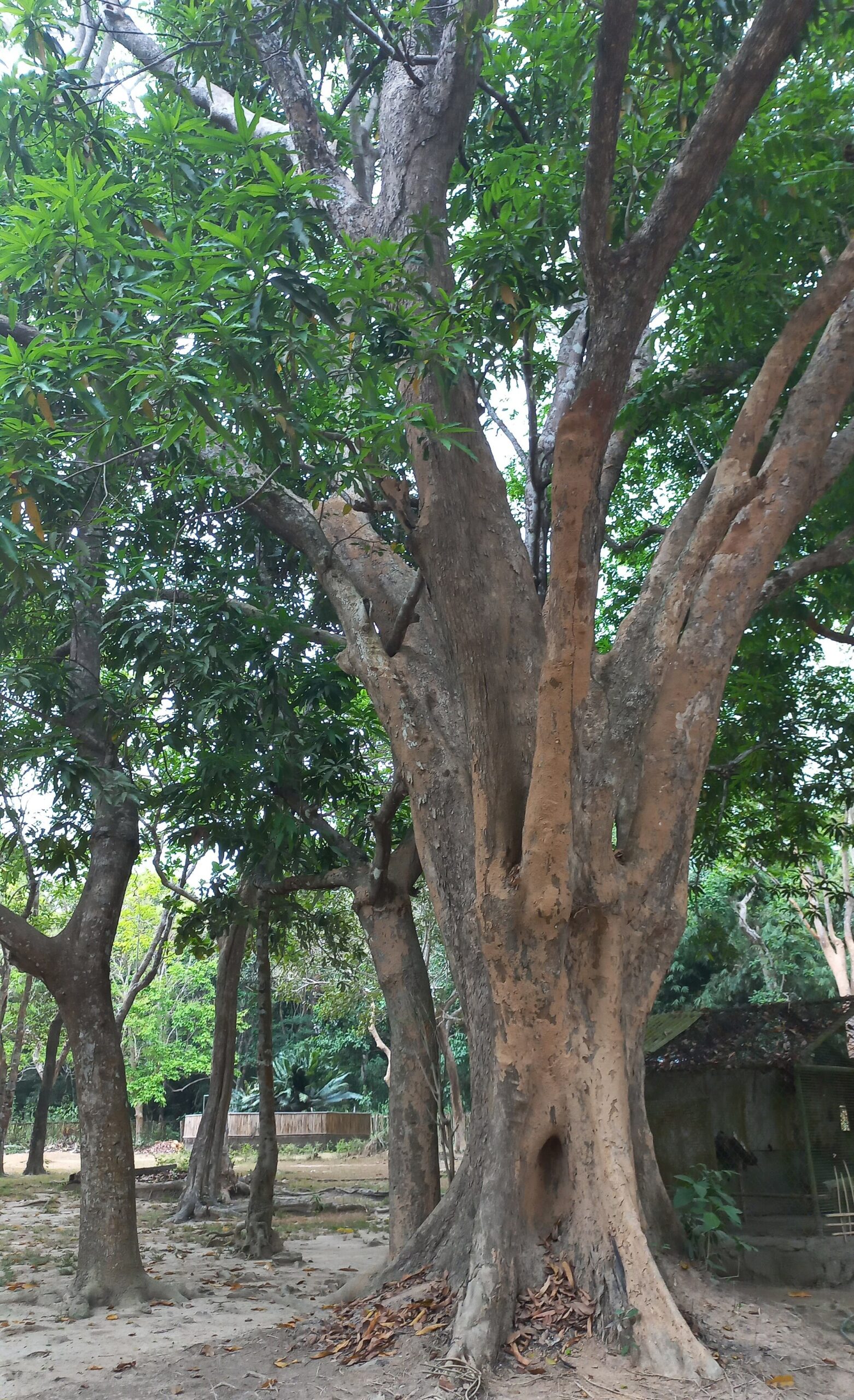
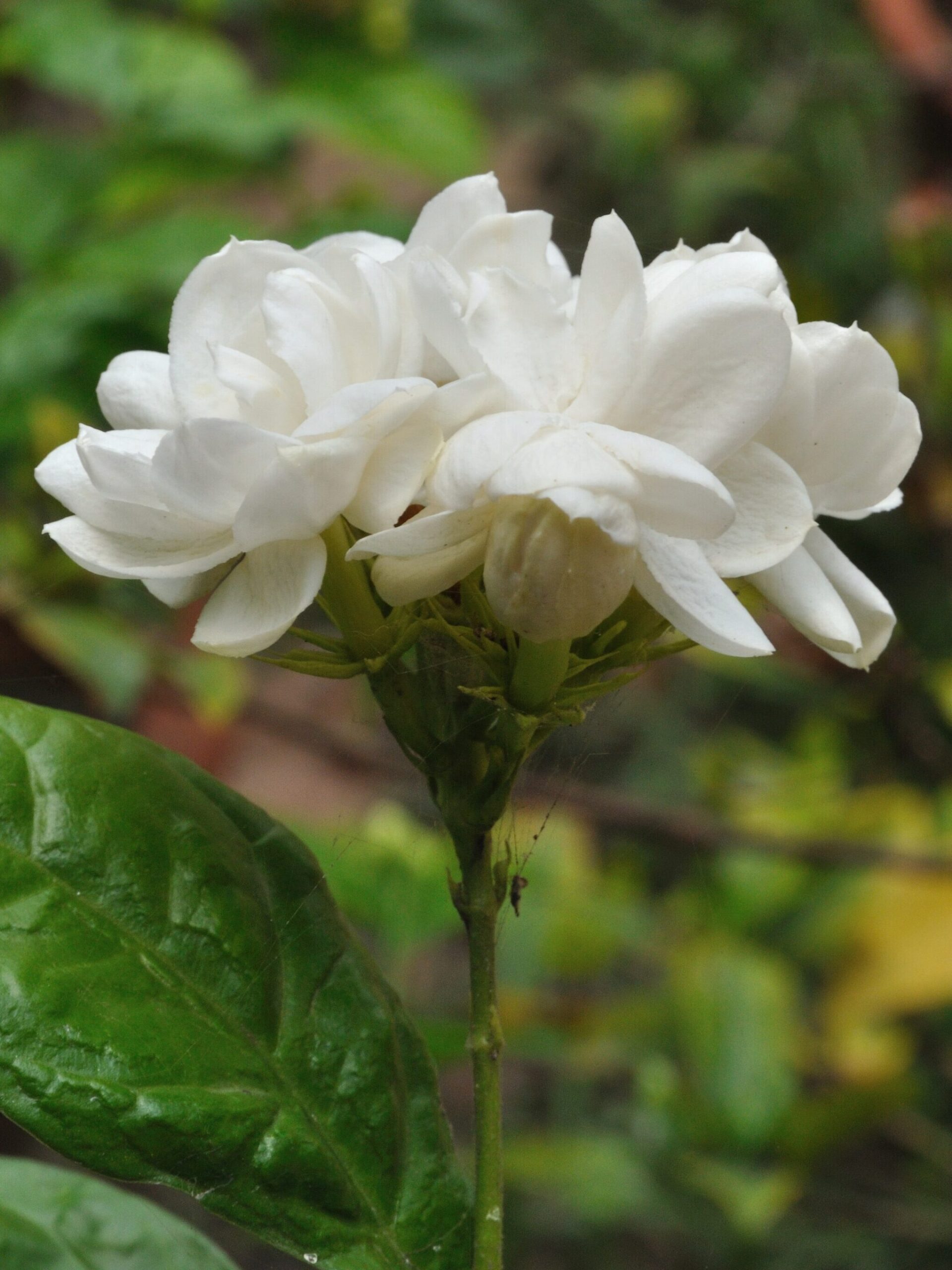
National Flower Sampaguita
The Sampaguita (Jasminum sambac), also known as Arabian Jasmine, is the official national flower of the Philippines. It was chosen in 1934 due to its cultural and symbolic significance.
Originally native to South Asia, it is now widespread across the Philippines. The plant is an evergreen shrub with small, white, highly fragrant flowers that usually bloom in the evening. It is commonly cultivated in home gardens.
The Sampaguita plays an important role in the daily life of many Filipinos, serving both as an ornamental flower and in religious ceremonies or traditional welcoming gestures. It is considered a symbol of reverence and devotion, particularly within the context of the widespread Catholic faith in the Philippines. On special occasions, such as greeting guests, dignitaries, or during festivals, flowers woven into garlands (leis) are presented as a sign of respect and warmth.
The white color of the flower traditionally represents purity and innocent beauty. In Philippine culture, the Sampaguita is often seen as a symbol of sincere love, loyalty, and humility. It is frequently mentioned in Filipino songs and poems. The folk song “Sampaguita” is regarded as a musical national symbol, comparable to an unofficial national anthem.
The flower is an expression of national identity: the modest yet fragrant and long-lasting bloom embodies humility and steadfastness – virtues attributed to the Filipino people.
Although not an endangered species, its symbolic status highlights the importance of native and culturally significant plants for the country’s natural and cultural heritage.
Bananas
Thanks to the tropical climate, the banana plant (Musa spp.) thrives in almost all parts of the Philippines and is one of the country’s most important crops.
In nature, banana plants help stabilize the soil and prevent erosion on slopes. Their large leaves provide shade, shelter, and habitat for numerous animal species. Even after harvest, the plant remains useful: the leaves are used as natural packaging or for cooking traditional dishes, while the fibers are used to make ropes, mats, or textiles.
The fruit itself is of great importance both for local consumption and export. There are more than 40 cultivated banana varieties in the Philippines belonging to the Musa genus. These can be roughly divided into two main groups: besides dessert bananas, cooking bananas also play a central role in the Filipino diet. Particularly important is the Saba variety – a starchy banana used in many traditional dishes such as turon, minatamis na saging, or ginataang halo-halo.
There are also wild species like Musa errans or Musa textilis (also known as Abacá), which are not primarily grown for fruit but for fiber production (Abacá fiber = Manila hemp).
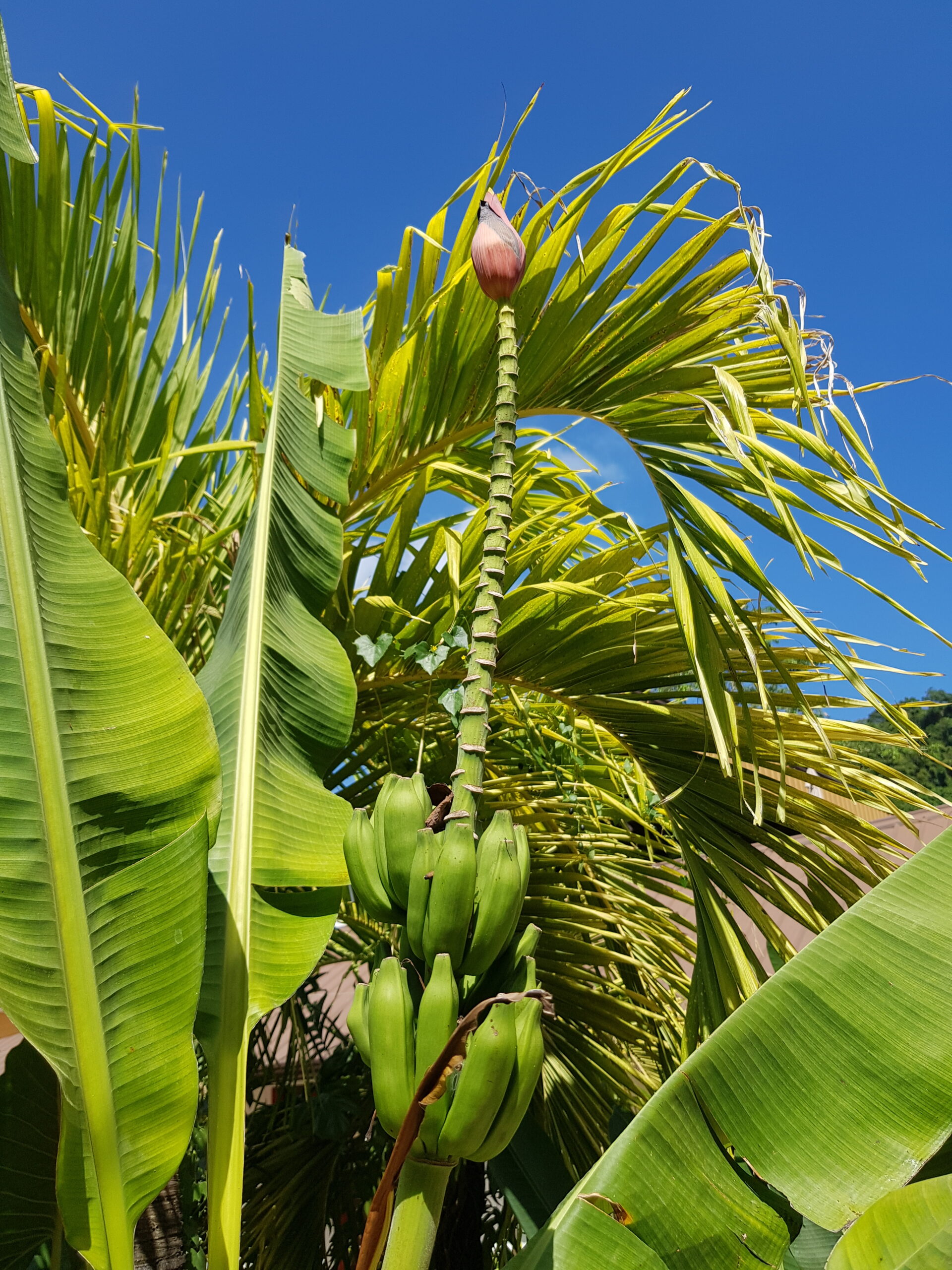
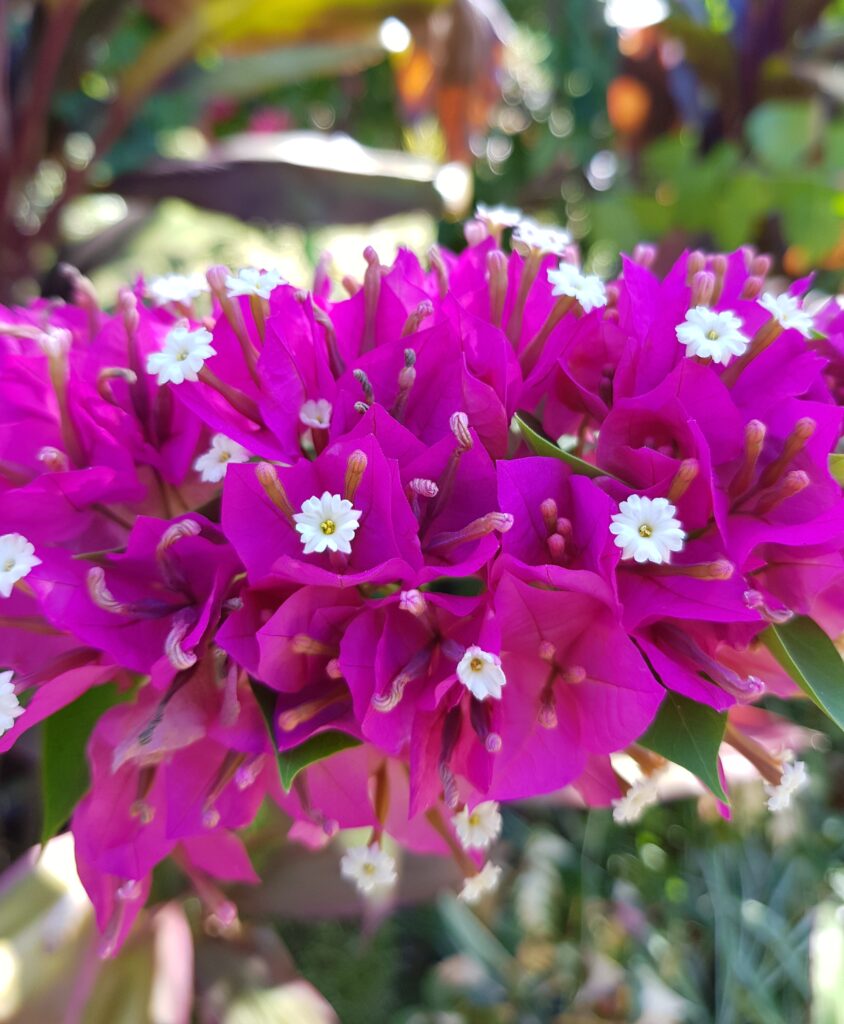
Bougainvillea
Whether as a flowering hedge, climbing plant, or colorful privacy screen, bougainvillea impresses with its bright, almost exuberant colors. The vibrant “flowers”, which are actually bracts, come in a variety of shades such as red, orange, pink, purple and white.
Originally from South America, this hardy plant has perfectly adapted to the tropical climate of the Philippines. It thrives effortlessly under high temperatures and strong sunlight. Especially during the dry season, when other plants bloom less, bougainvillea puts on a true display of color.
Coconut Palm
The coconut palm (Cocos nucifera) is omnipresent in the Philippines and rightfully known as the tree of life. Thriving in the islands’ tropical climate, especially along the coasts, it provides a wide range of resources – from food and building materials to sources of health.
The Philippines is among the world’s largest exporters of coconut products. Highly sought after are coconut oil, coconut water, dried coconut meat (copra), and coconut flour. The coconut palm is not only economically important but also an essential part of everyday life, offering natural support in cooking, medicine, and daily use.
Its fruits – the coconuts – are rich in minerals, healthy fats, and antibacterial compounds. Coconut water is traditionally used to rehydrate during diarrhea or fever. Coconut oil has anti-inflammatory properties, promotes skin healing, and is widely used in hair and skin care.
Other parts of the palm are also utilized: the fibers are made into sustainable ropes, mats, and brushes, while the leaves are traditionally woven into baskets, hats, and roofing materials.
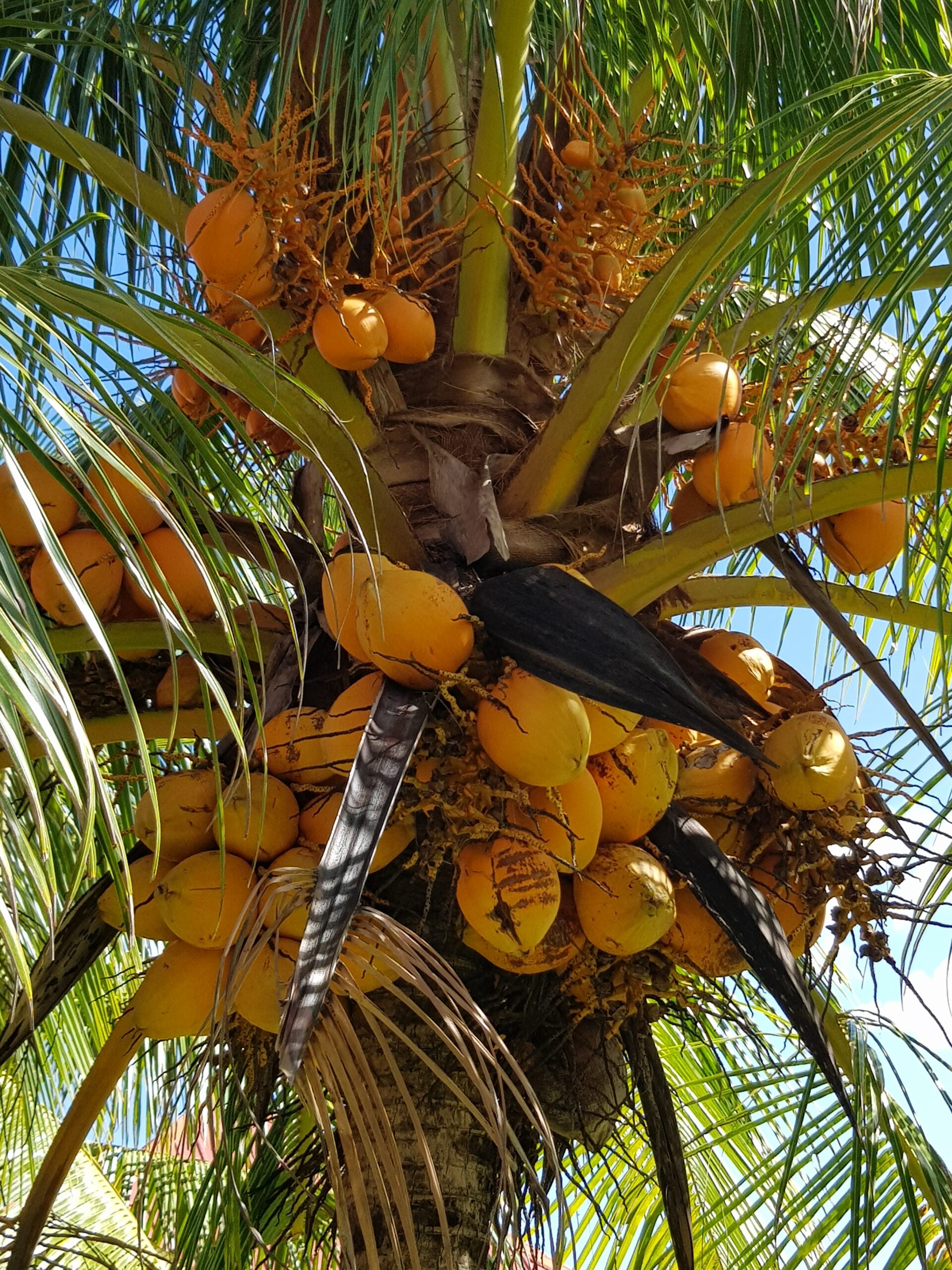
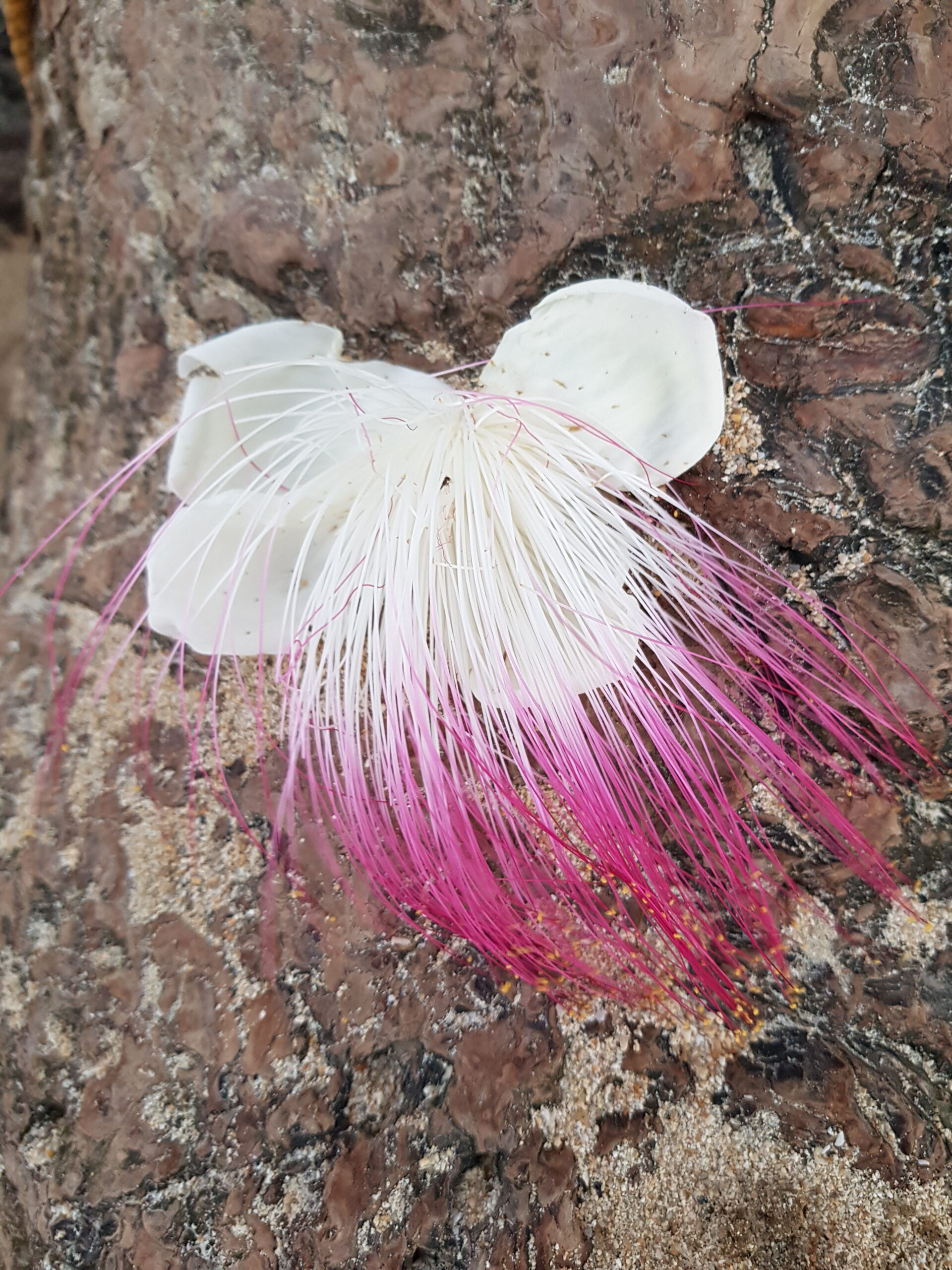
Fish Poison Tree
The fish poison tree (known as Balete in the Philippines, Barringtonia asiatica) is an impressive coastal tree native to the Philippines. With its glossy leaves and striking white-pink flowers – whose long, delicate stamens bloom at night and emit a sweet fragrance – it shapes many coastal landscapes.
Its fruits are also distinctive: pyramid-shaped with rounded edges. Initially green and soft, they turn brown, harden, and become woody as they mature. In this state, the fruits can float in the sea for weeks, washing up on shores and spreading further.
The seeds contain abundant saponins – soap-like compounds that can be deadly to fish. When crushed and released into the water, these substances block oxygen absorption through the fish’s gills. The fish float to the surface and can be easily collected. This traditional fishing method, known as fish stunning or poisoning, is still practiced in some coastal villages today. However, it is now banned in many regions: while the fish are primarily stunned, some do die – especially when the exposure lasts too long or the dose of poison is high. Moreover, the toxins released in the process endanger not only fish but also other aquatic organisms and entire ecosystems.
In Philippine folk medicine, the fish poison tree also plays a role: its bark and seeds are used to treat skin diseases, inflammation, and as a natural insect repellent.
Straddling the line between poison and cure, this tree embodies nature’s contrasting powers – dangerous to fish, yet beneficial to humans.
Heliconia
When strolling through Philippine gardens, sooner or later you’ll come across an exotic beauty with red, pink, orange, or yellow bracts that are often mistaken for flowers: Heliconia, also known as lobster claw or false bird of paradise. It belongs to the family Heliconiaceae, which is closely related to the banana family.
Heliconia thrives especially well in moist, tropical regions. In the Philippines, it is widespread both in the wild and as a popular ornamental plant. With its striking shape and bright colors, it is a true eye-catcher and attracts numerous pollinators, especially hummingbirds and butterflies. In rural areas, it is sometimes also used for festive decorations or ceremonies.
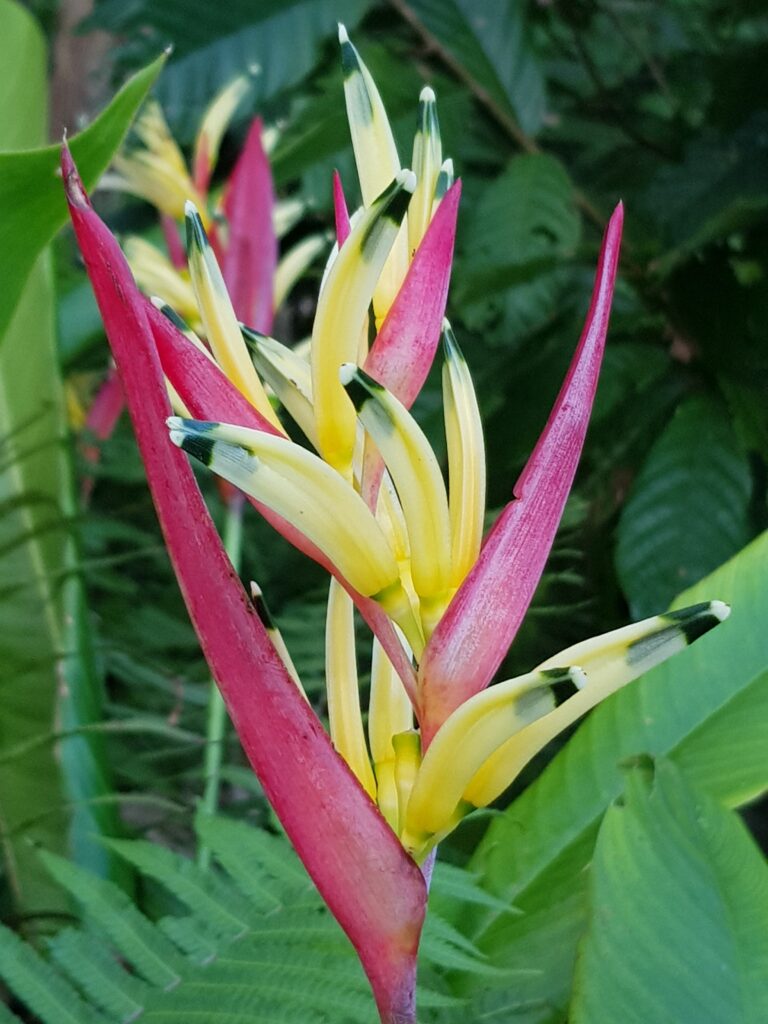
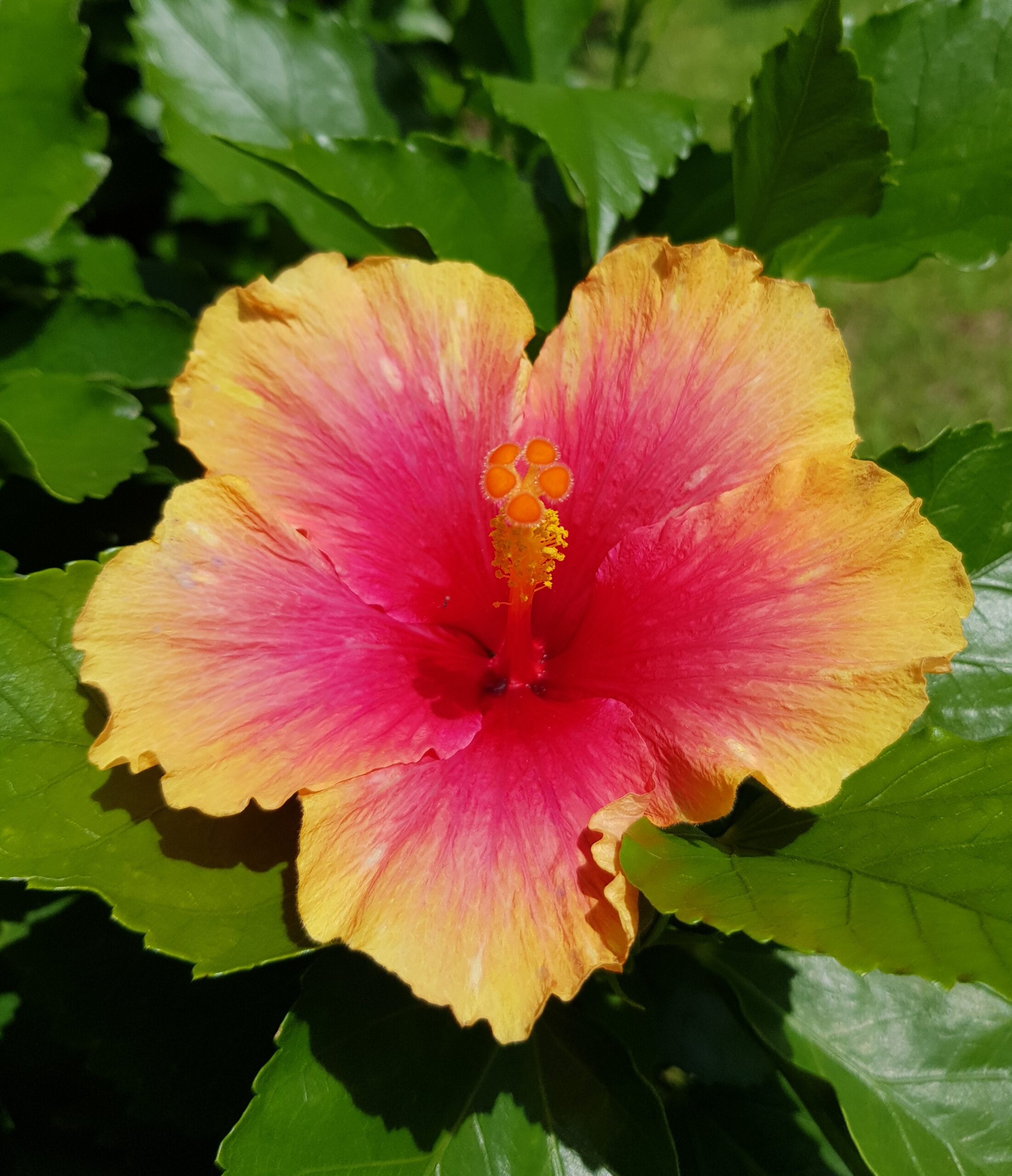
Hibiscus
Whether as an ornamental plant, a symbol of childhood, or a medicinal herb, Gumamela (Hibiscus rosa-sinensis) is simply part of everyday life in the Philippines. With its bright, often hand-sized flowers in red, pink, orange or yellow, it brings a tropical touch to any place – it even grows in our own homes.
Gumamela is more than just eye candy. For many Filipinos, it evokes childhood memories: in the Gumamela bubble game, hibiscus flowers and leaves are crushed and mixed with soapy water to create a sticky, natural bubble solution. From this, soap bubbles (Gumamela bubbles) are made.
It also holds a place in traditional healing practices. Hibiscus flower teas are used to treat coughs and high fevers, and crushed leaves serve as a cooling compress for swelling or minor wounds.
Ixora
At first glance, it is simply beautiful: the bright red Ixora (Ixora coccinea, also known as jungle geranium), called Santan in the Philippines. It is not only an ornamental plant but also part of the traditional healing plant culture. In Filipino folk medicine, the plant has long been regarded as a natural remedy: a soothing tea made from the flowers is used to treat fever and stomach ailments, while crushed leaves serve as an antiseptic poultice for minor skin injuries. The roots are believed to help with diarrhea.
Knowledge of Ixora’s healing properties is passed down from generation to generation. The plant is not only important in traditional medicine – it is also present in the daily lives of many children, who pick the bright flowers to sip their sweet nectar.
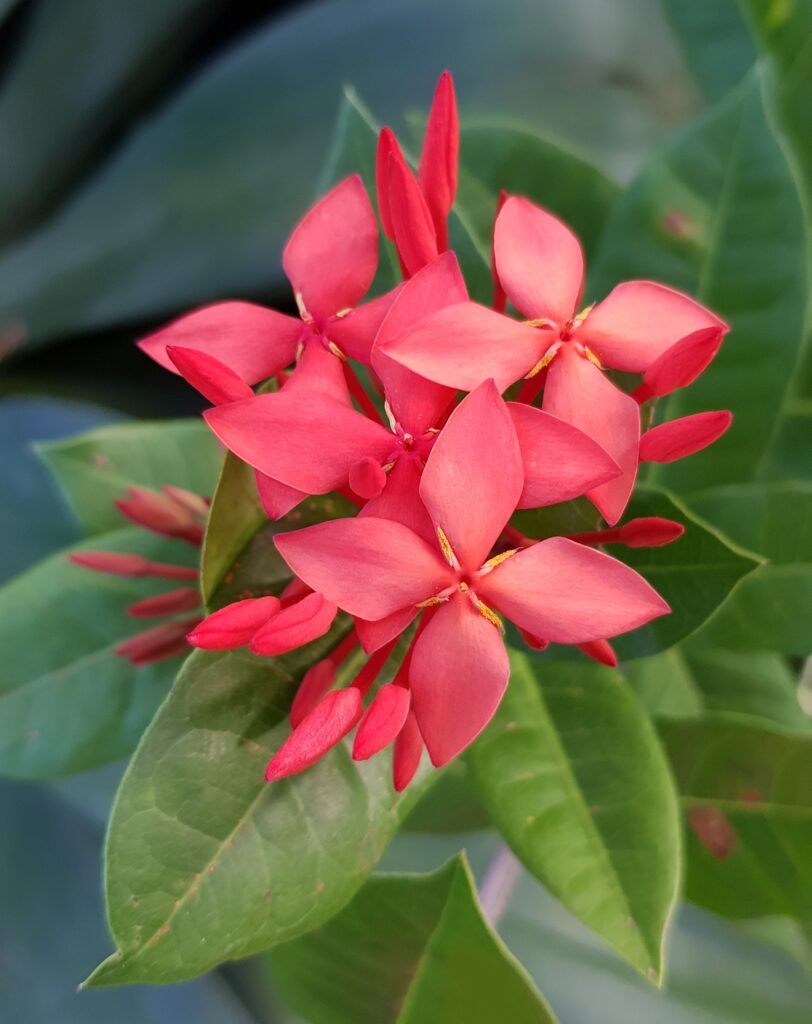
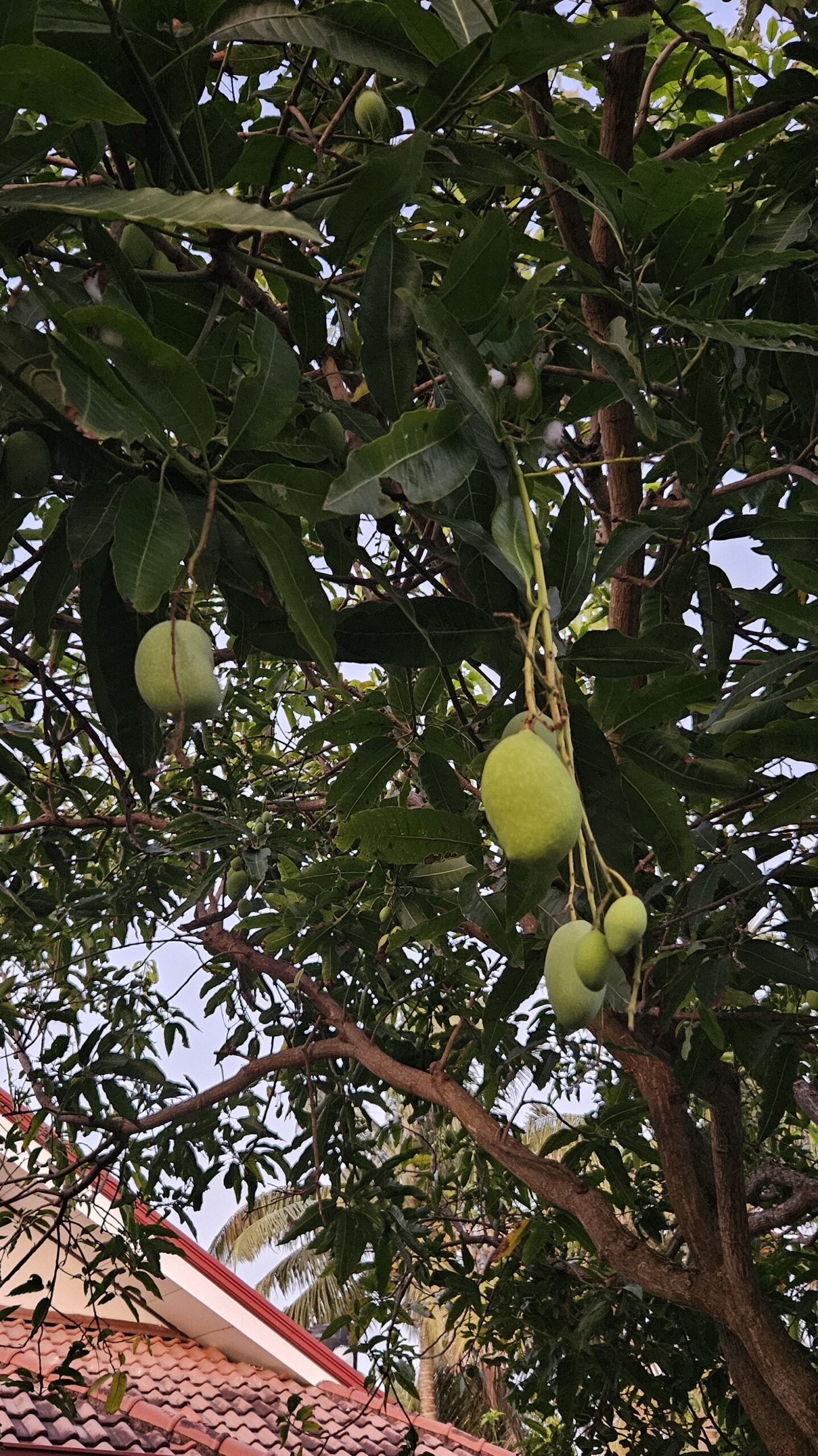
Mango Tree
The sturdy mango tree (Mangifera indica) can grow over 35 meters tall and live for a very long time. An age of 100 to 150 years is quite common for a mango tree – some specimens can even reach up to 300 years old. Its expansive crown, which can reach a diameter of 30 meters, provides not only ample shade but also habitat for many animals. On plantations, the tree is usually kept smaller by pruning to facilitate harvesting.
The mango is considered one of the most popular and well-known tropical fruits. There are over 60 different varieties on the Philippines. The diversity ranges from sweet dessert mangos to varieties more suitable for cooking or producing mango powder as a versatile spice. The most famous and internationally valued variety is the Carabao mango (also called Manila mango), known for its particularly sweet and juicy flesh.
Mango skin color varies greatly depending on the variety and is therefore not a reliable indicator of ripeness. Unripe fruits are usually green; ripe mangos can also be green, yellow, red, or orange. More important indicators of ripeness are a sweet aroma and slight softness to the touch – similar to papayas.
Whether fresh, dried, in sauces, or desserts, mangos are nutrient-rich fruits. They contain high amounts of vitamins C and A, which strengthen the immune system and support skin and eye health. Additionally, mangos provide fiber for good digestion, folate for cell health, and potassium to regulate blood pressure. Their antioxidants protect cells and have anti-inflammatory effects.
In traditional folk medicine, mango leaves are often used as tea to relieve diarrhea or to help regulate blood sugar levels. Extracts from leaves and fruits are also considered anti-inflammatory and are believed to promote wound healing.
Orchids
With over 1,100 native species – many of which are endemic, meaning they only occur here – the Philippines is one of the richest regions worldwide for orchids. However, this beauty is also threatened: habitat loss and illegal wild collection endanger many species. Therefore, botanical gardens, indigenous communities, and conservation organizations are increasingly committed to their protection and sustainable cultivation.
One of the best-known species is the Waling-Waling (which means “beautiful goddess”, Vanda sanderiana). It originates from Mindanao and is so popular because of its striking flowers that it was even proposed as a national flower alongside the Sampaguita.
Orchids on the Philippines grow not only in gardens or greenhouses but also wild in rainforests, on tree trunks, rocks, or even in highland climates. Their flower shapes and colors range from simple and delicate to spectacular and vivid – a reflection of the country’s tropical diversity.
There are even orchid trees: although the Hong Kong orchid tree (Bauhinia × blakeana) originally comes from Hong Kong (humid subtropical with four seasons), it thrives exceptionally well in the Philippine climate (tropical maritime with a rainy and a dry season). Heat, strong sunlight, and tropical rains hardly affect it. The Hong Kong orchid tree blooms profusely, usually in the cooler months, and attracts not only people but also insects and birds with its large, orchid-like, mildly sweet-scented flowers. Since the tree does not produce seeds, it reproduces only by cuttings. This prevents uncontrolled spreading and makes it especially easy to care for in urban environments, such as Manila. There, it is often planted as a shade provider and for decorative purposes.
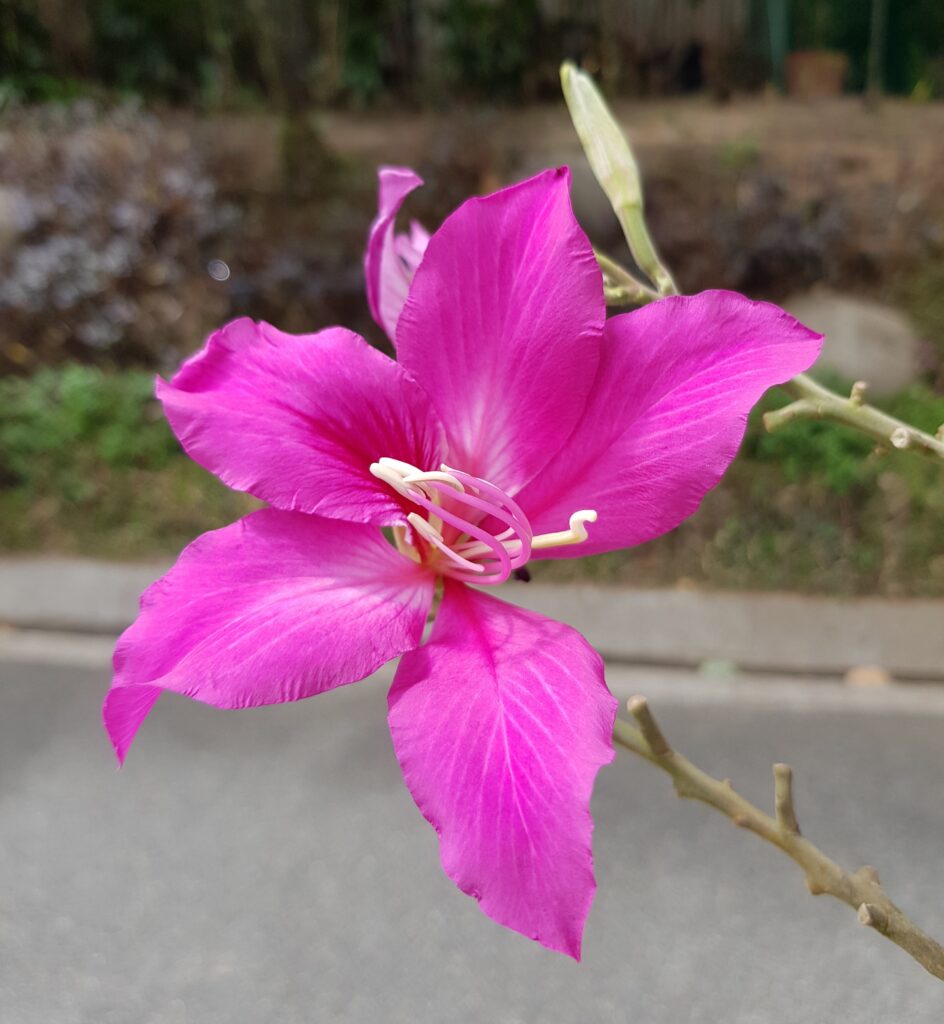
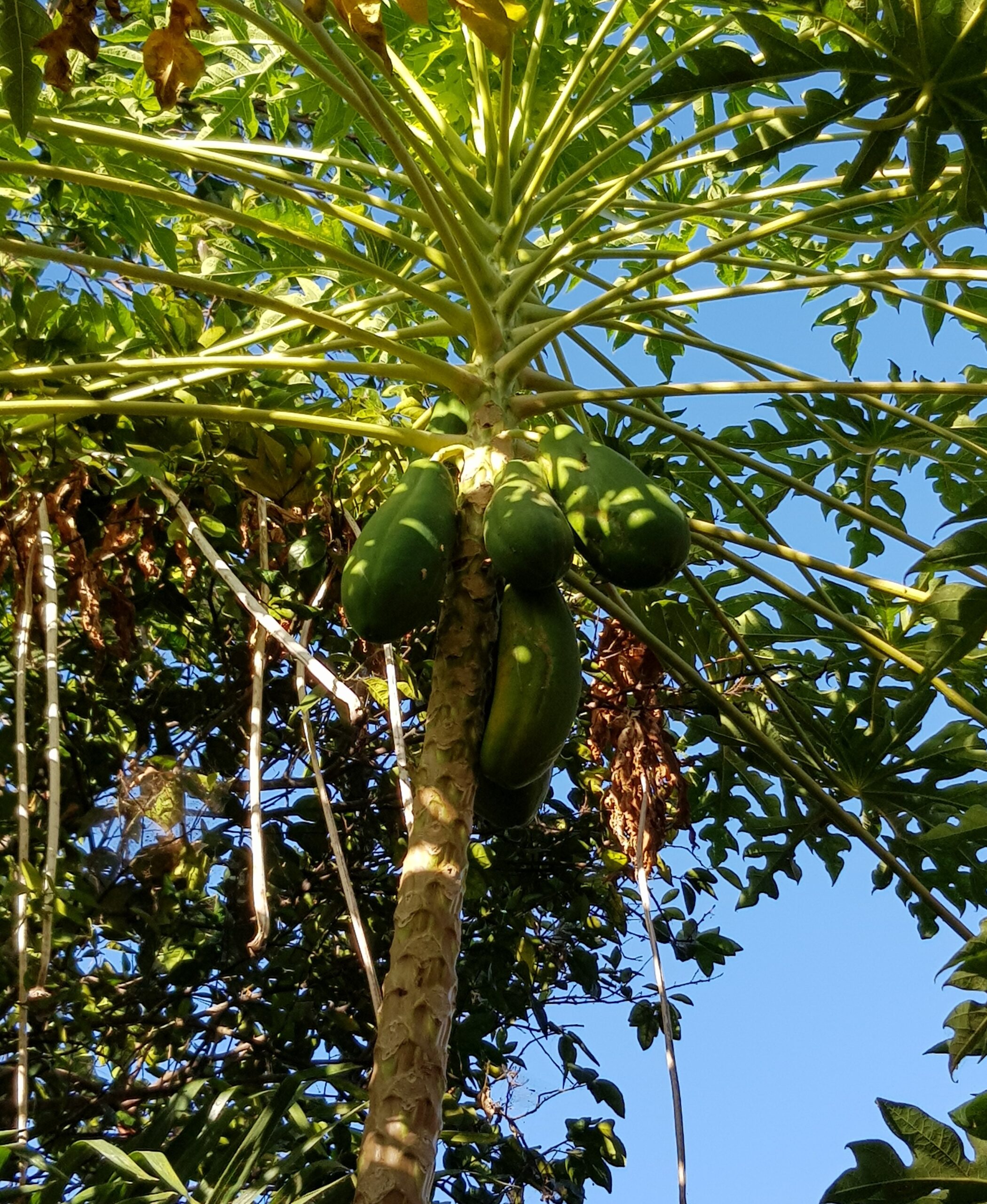
Papaya
The papaya (Carica papaya) is a widely cultivated fruit plant in the Philippines. It thrives particularly well in the warm, humid tropical climate and can be found both in home gardens and on agricultural land.
The plant is undemanding, grows quickly, and often bears fruit within the first year. Ripe papayas are usually yellow to orange, but some varieties have green skin even when the flesh is soft and ripe. Color alone is not a reliable indicator of ripeness – softness to the touch and aroma are often better clues. The ripe, sweet fruits are rich in vitamins, especially vitamins C and A, and are considered a healthy staple food. Unripe fruits are also used, for example in savory dishes like the traditional tinola (a light chicken soup with green papaya flesh).
Besides the fruit, other parts of the plant are utilized as well: the leaves are regarded in traditional medicine as a natural remedy for fever or to aid digestion. The brown-black papaya seeds are not discarded but traditionally used in various ways in the Philippines. Thanks to the enzyme papain, they are considered a natural remedy against intestinal parasites and to support digestion in home remedies. They are also used in small amounts to strengthen the liver and combat harmful bacteria. Dried and ground, papaya seeds serve as a pepper-like spice: sharp, slightly bitter, and aromatic. In the garden, new plants can be grown from the seeds, or they can be used as a natural pest repellent.
Taro
Taro (Colocasia esculenta) is a traditional crop in the Philippines, though it is not native. It originates from Southeast Asia and India and has spread over millennia to many tropical regions.
The leaves are large and heart-shaped and are used as a vegetable in many countries. They are usually boiled or steamed and are an important ingredient in the traditional Filipino dish laing. When properly prepared, taro leaves have a slightly earthy flavor and a tender, almost creamy texture.
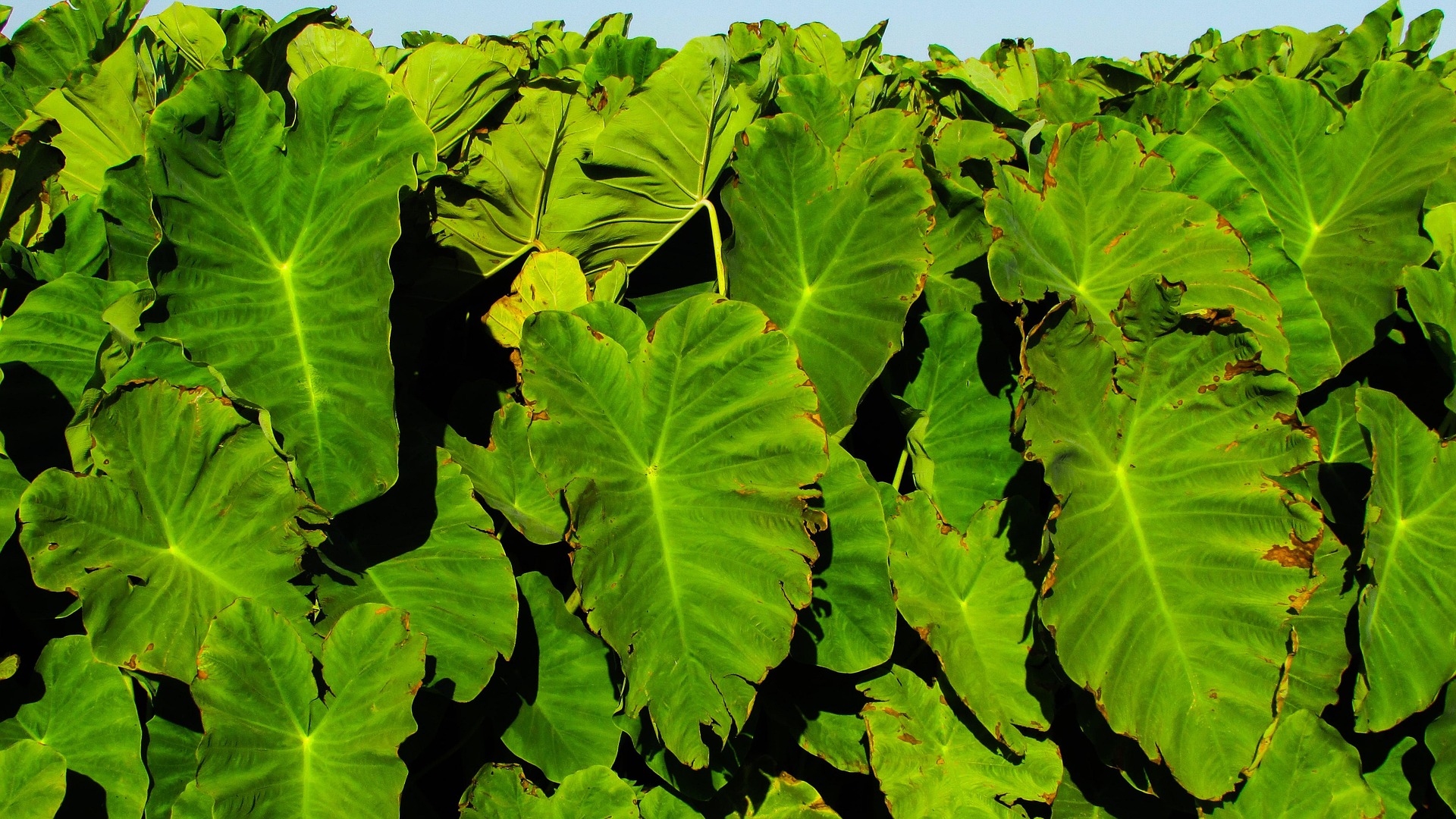
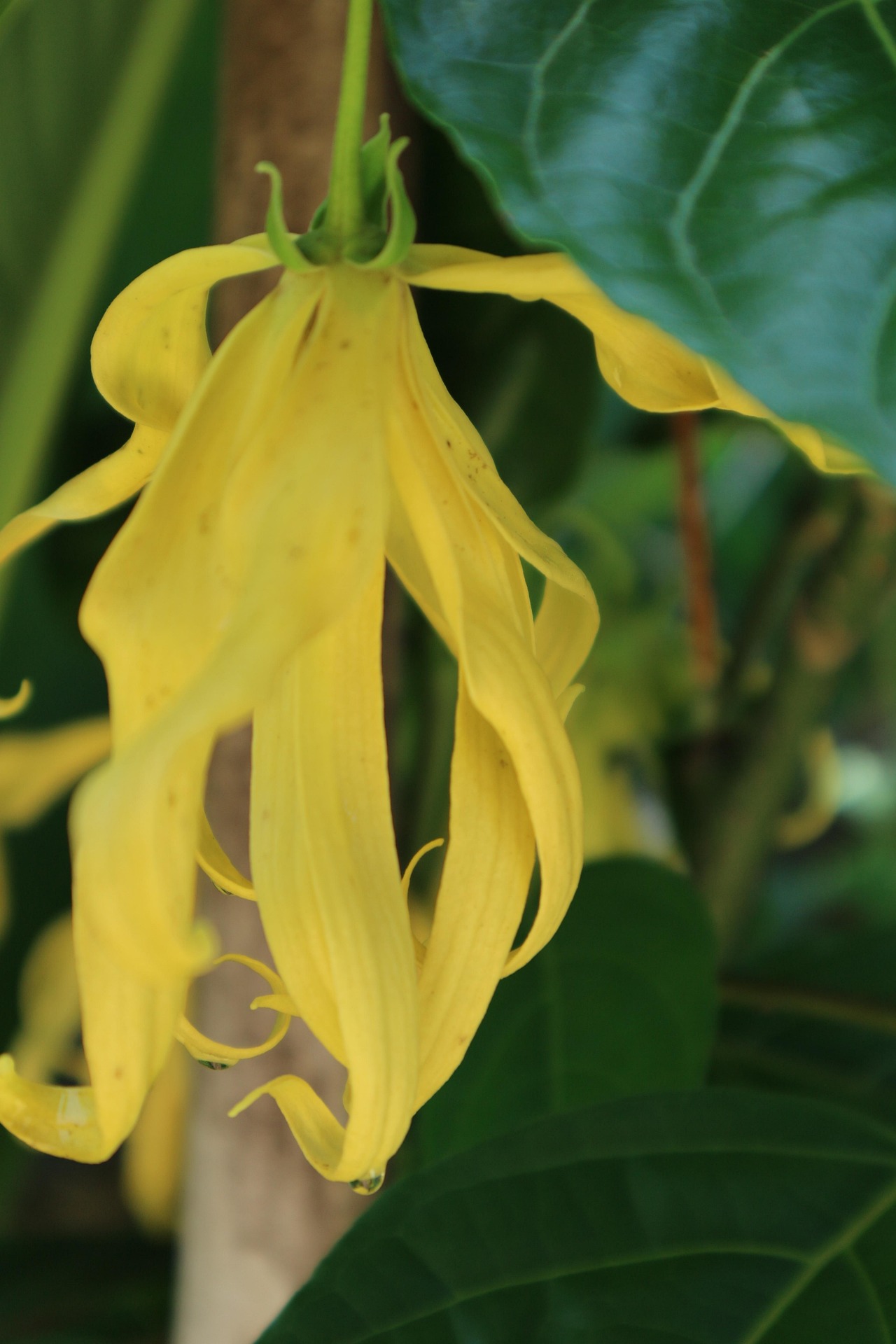
Ylang-Ylang
In the Philippines grows a plant whose fragrance is valued worldwide: Ilang-Ilang (Cananga odorata), also internationally known as Ylang-Ylang. With its delicate yellow, star-shaped flowers, it is not only a visual delight but also an important plant in traditional culture. In many Philippine gardens, Ylang-Ylang is prized as an evergreen fragrant plant that grows quickly and can develop into a tree up to 25 meters tall. Its sweet, exotic floral scent is especially intense in the early morning hours – one reason it is used in religious ceremonies, house blessings, and weddings.
Especially in rural areas, the Ylang-Ylang tree is also used as a natural remedy because its flowers and the oil derived from them possess a range of calming, skin-care, and heart-strengthening properties.
Economically, Ylang-Ylang also plays a role in the international perfume industry: the fragrant essential oil is a sought-after raw material for high-quality perfumes worldwide, including the legendary Chanel No. 5.




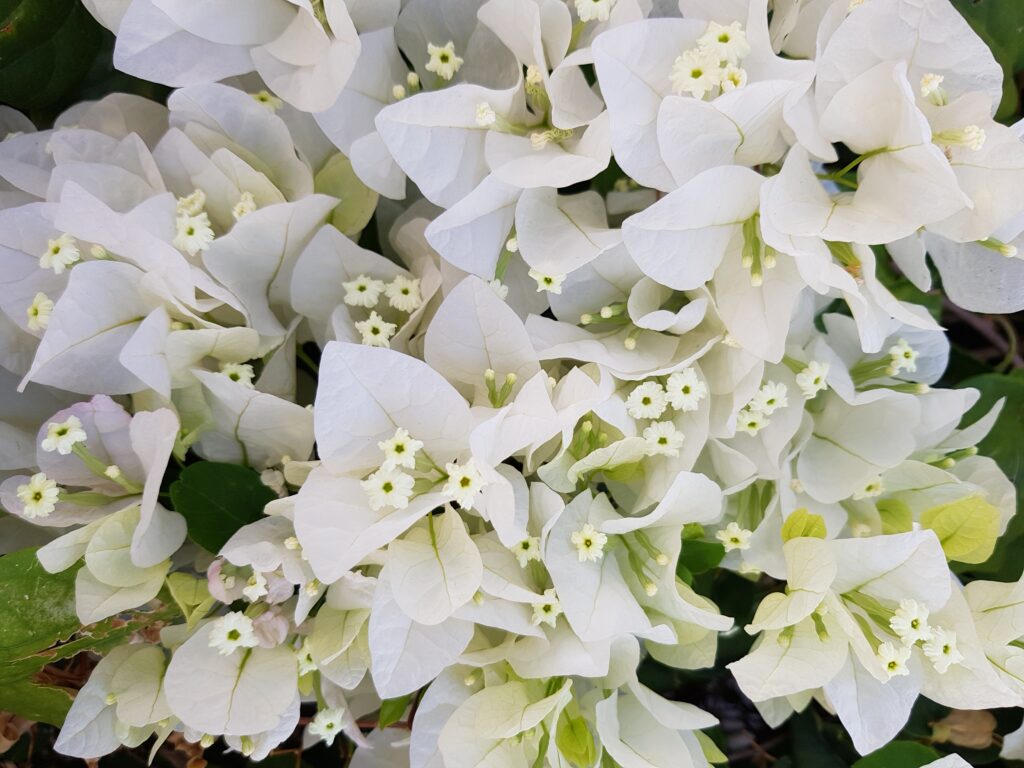
Leave a Reply